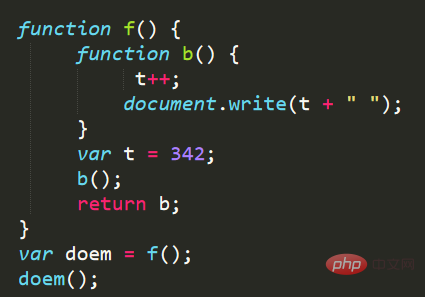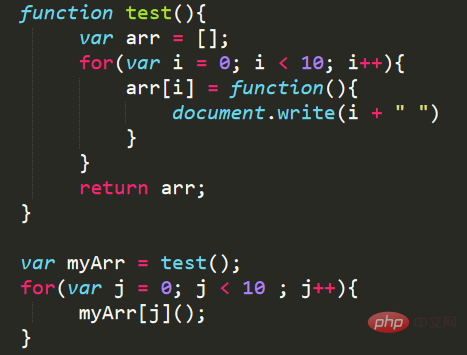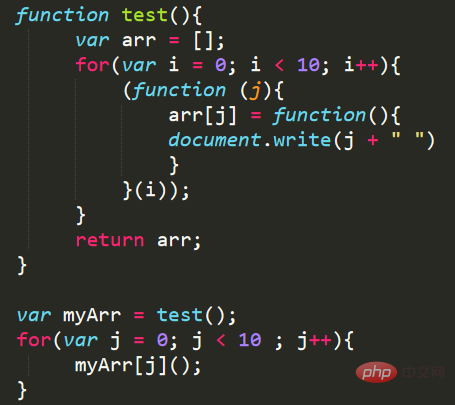 Web Front-end
Web Front-end
 JS Tutorial
JS Tutorial
 What do js closures and scope chains mean? Detailed explanation of js closure and scope chain
What do js closures and scope chains mean? Detailed explanation of js closure and scope chain
What do js closures and scope chains mean? Detailed explanation of js closure and scope chain
In the process of learning js, you must know and understand closures. Closure is unique to js compared to other programming languages. The following is my understanding of closures.
Generation of closures: In layman's terms, closures are generated between nested functions. When the inner function is saved outside, the closure will be generated. [Recommended reading: JavaScript Video Tutorial]
Scope chain: My understanding is that when accessing a function, chain access is used, and the area accessed is a scope chain.

In this code, f() is accessed first, then b(), and then c(). In this example, it is reflected A chained access process.
Let’s talk about the role of closure
Benefits of closure:
First: Accumulation of functions Second: Cache structure Third: Encapsulation Fourth Modular
Disadvantages of closures:
Closures will cause the original scope chain to not be released, causing memory leaks.
The following are some practical examples of closures:

#In this closure example, if there is no return b statement, when calling this function, The value of f() can only be 342; when this statement is issued, the printed values increase sequentially. This is an effect produced by the closure.

When you execute this code, you will find that the result you printed is 10 10s, but why does this effect occur? Then how to solve this effect?

#When this code is executed, you will find that the printed results are from 0 to 9 in ascending order.
The reason for the above 10 10s is actually caused by closure, where
arr[i] = function(){ document.write(i " ") } This statement It is a function expression. At this time, arr[i] and document.write(i " ") are not corresponding. document.write(i " ") is an output statement, which only comes after the for loop in the entire function has been executed. Looking at this statement, due to the closure, i at this time increases sequentially due to the for loop. Until the end of the statement, i is 10, so the printed result is 10 10.
Why is it below? Will print out 10 numbers from 0 to 9. Here we use the immediate execution function.
There are two forms of immediate execution function: (function (){}(); (function (){ })(); Usually the first method is used.
So what is an immediate execution function? In fact, it can be summarized as a function that is only executed once. After it is executed once, it cannot be called or executed. Therefore, In the subsequent process of outputting 0 to 9, since i is an actual parameter at this time, every time it is passed to the immediate execution function, j is the value of i at this time, but the entire expression has not yet been executed. So the final output When , it will naturally output the 10 numbers from 0 to 9.
The above is the detailed content of What do js closures and scope chains mean? Detailed explanation of js closure and scope chain. For more information, please follow other related articles on the PHP Chinese website!

Hot AI Tools

Undresser.AI Undress
AI-powered app for creating realistic nude photos

AI Clothes Remover
Online AI tool for removing clothes from photos.

Undress AI Tool
Undress images for free

Clothoff.io
AI clothes remover

AI Hentai Generator
Generate AI Hentai for free.

Hot Article

Hot Tools

Notepad++7.3.1
Easy-to-use and free code editor

SublimeText3 Chinese version
Chinese version, very easy to use

Zend Studio 13.0.1
Powerful PHP integrated development environment

Dreamweaver CS6
Visual web development tools

SublimeText3 Mac version
God-level code editing software (SublimeText3)

Hot Topics
 1378
1378
 52
52
 Detailed explanation of the mode function in C++
Nov 18, 2023 pm 03:08 PM
Detailed explanation of the mode function in C++
Nov 18, 2023 pm 03:08 PM
Detailed explanation of the mode function in C++ In statistics, the mode refers to the value that appears most frequently in a set of data. In C++ language, we can find the mode in any set of data by writing a mode function. The mode function can be implemented in many different ways, two of the commonly used methods will be introduced in detail below. The first method is to use a hash table to count the number of occurrences of each number. First, we need to define a hash table with each number as the key and the number of occurrences as the value. Then, for a given data set, we run
 Detailed explanation of obtaining administrator rights in Win11
Mar 08, 2024 pm 03:06 PM
Detailed explanation of obtaining administrator rights in Win11
Mar 08, 2024 pm 03:06 PM
Windows operating system is one of the most popular operating systems in the world, and its new version Win11 has attracted much attention. In the Win11 system, obtaining administrator rights is an important operation. Administrator rights allow users to perform more operations and settings on the system. This article will introduce in detail how to obtain administrator permissions in Win11 system and how to effectively manage permissions. In the Win11 system, administrator rights are divided into two types: local administrator and domain administrator. A local administrator has full administrative rights to the local computer
 Detailed explanation of division operation in Oracle SQL
Mar 10, 2024 am 09:51 AM
Detailed explanation of division operation in Oracle SQL
Mar 10, 2024 am 09:51 AM
Detailed explanation of division operation in OracleSQL In OracleSQL, division operation is a common and important mathematical operation, used to calculate the result of dividing two numbers. Division is often used in database queries, so understanding the division operation and its usage in OracleSQL is one of the essential skills for database developers. This article will discuss the relevant knowledge of division operations in OracleSQL in detail and provide specific code examples for readers' reference. 1. Division operation in OracleSQL
 Detailed explanation of remainder function in C++
Nov 18, 2023 pm 02:41 PM
Detailed explanation of remainder function in C++
Nov 18, 2023 pm 02:41 PM
Detailed explanation of the remainder function in C++ In C++, the remainder operator (%) is used to calculate the remainder of the division of two numbers. It is a binary operator whose operands can be any integer type (including char, short, int, long, etc.) or a floating-point number type (such as float, double). The remainder operator returns a result with the same sign as the dividend. For example, for the remainder operation of integers, we can use the following code to implement: inta=10;intb=3;
 Detailed explanation of the usage of Vue.nextTick function and its application in asynchronous updates
Jul 26, 2023 am 08:57 AM
Detailed explanation of the usage of Vue.nextTick function and its application in asynchronous updates
Jul 26, 2023 am 08:57 AM
Detailed explanation of the usage of Vue.nextTick function and its application in asynchronous updates. In Vue development, we often encounter situations where data needs to be updated asynchronously. For example, data needs to be updated immediately after modifying the DOM or related operations need to be performed immediately after the data is updated. The .nextTick function provided by Vue emerged to solve this type of problem. This article will introduce the usage of the Vue.nextTick function in detail, and combine it with code examples to illustrate its application in asynchronous updates. 1. Vue.nex
 Detailed explanation of the role and usage of PHP modulo operator
Mar 19, 2024 pm 04:33 PM
Detailed explanation of the role and usage of PHP modulo operator
Mar 19, 2024 pm 04:33 PM
The modulo operator (%) in PHP is used to obtain the remainder of the division of two numbers. In this article, we will discuss the role and usage of the modulo operator in detail, and provide specific code examples to help readers better understand. 1. The role of the modulo operator In mathematics, when we divide an integer by another integer, we get a quotient and a remainder. For example, when we divide 10 by 3, the quotient is 3 and the remainder is 1. The modulo operator is used to obtain this remainder. 2. Usage of the modulo operator In PHP, use the % symbol to represent the modulus
 Detailed explanation of the linux system call system() function
Feb 22, 2024 pm 08:21 PM
Detailed explanation of the linux system call system() function
Feb 22, 2024 pm 08:21 PM
Detailed explanation of Linux system call system() function System call is a very important part of the Linux operating system. It provides a way to interact with the system kernel. Among them, the system() function is one of the commonly used system call functions. This article will introduce the use of the system() function in detail and provide corresponding code examples. Basic Concepts of System Calls System calls are a way for user programs to interact with the operating system kernel. User programs request the operating system by calling system call functions
 Detailed explanation of Linux curl command
Feb 21, 2024 pm 10:33 PM
Detailed explanation of Linux curl command
Feb 21, 2024 pm 10:33 PM
Detailed explanation of Linux's curl command Summary: curl is a powerful command line tool used for data communication with the server. This article will introduce the basic usage of the curl command and provide actual code examples to help readers better understand and apply the command. 1. What is curl? curl is a command line tool used to send and receive various network requests. It supports multiple protocols, such as HTTP, FTP, TELNET, etc., and provides rich functions, such as file upload, file download, data transmission, proxy



